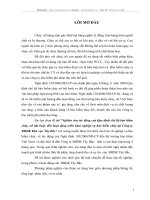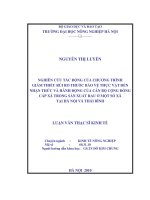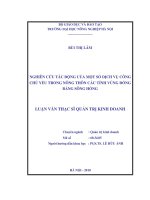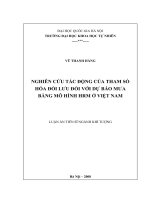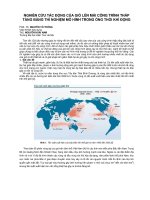Báo cáo "Nghiên cứu tác động của các phức vòng càng giữa các nguyên tố đất hiếm nhẹ và isolơxin tới sự tăng trưởng của nấm Hericium Erinaceum " pptx
Bạn đang xem bản rút gọn của tài liệu. Xem và tải ngay bản đầy đủ của tài liệu tại đây (165.92 KB, 6 trang )
TAP CHi KHOA HQC VA
CONG
NGHE Tap 47, so 5, 2009 Tr. 27-32
STUDY ON EFFECT OF LIGHT RARE EARTH - ISOLEUCINE
CHELATE ON
HERICIUM
ERINACEUM GROWTH
LE
MINH
TUAN,
NGUYEN
THI
CHINH,
NGUYEN TRONG
UYEN,
NGUYEN DINH BANG
ABSTRACT
Today, the use of rare earth elements (REE) as trace nutrients in agriculture including
plants and animals is widely practiced in some countries. In general, it is known that many
organic compounds of REE are capable of influencing many physicochemical and biological
processes taking place in the root-soil interface, such as uptake of nutrients by plants as well as
microbe interactions.
This paper dealt with the effect of light rare earth elements (REE) isoleucine chelates on the
growth of Hericium erinaceum mushroom at the different total rare earth concentrations. In our
experiments, mixed light REE isoleucine chelates were applied in order to evaluate its potential.
The obtained results showed that light REE isoleucine chelates have significant good effect on
mycelia growth of this mushroom. The growth of Hericium erinaceum mushroom was
stimulated when total rare earth element contents reached 100 ppm - 200 ppm. When REE
contents were higher than 300 ppm, the growth of mushroom was inhibited.
Key words. Hericium erinaceum, rare earth elements, chelate,
L-isoleucine.
1.
INTRODUCTION
Rare earth elements (REE) and their compounds are widely applied in agronomic and
medical fields for many years. The bioinorganic chemical research of REE during the past years
indicates that REE play important roles in the promotion of photosynthetic rate as well as root
absorption, regulation of hormone and nitrogen metabolism, and suppression of microbes, etc [I
- 3]. The metallic or non-metallic targets of key biomolecule in various physiological processes
can be chosen by REE for the chelation or replacement,
wiiich
enables REE to regulate the
biological functions or behaviors of those biomolecule and consequently leads to significant
embodiment of biological function of REE in plants and microbes
[1,4-8].
In China, extensive research started in 1972, involving both pot trials and field
demonstrations, and since then a great variety of plant species has been tested. Different
methods of rare earth applications and various concentrations, mostly low ones, have thereby
been investigated. To date, yield increases for 50 plant species of trees and pasture grasses have
been reported
[1,3].
Hericium erinaceum, commonly called"yamabushitake or lion's mane" is notable for its
use in treatment of diverse diseases such as gastritis, gastric ulcer, and tumors
[11].
This
mushroom has also been known to contain diverse
pharmaceutical
ly important compounds such
as novel phenols and fatty acids that have possible chemotherapeutic effect on calcer and
ameliorative effect in Alzheimer's dementia cases [12, 13].
Recently, no any relevant research on application of rare earth chelates in the mushroom
cultivation technology is found [1]. Therefore, to improve productivity and product quality of
27
mushrooms, especially the special mushroom used for medicinal purposes, we have studied the
influence of rare earth isoleucine chelates on the growth of H. erinaceum - a type of good
mushroom: food and medicine for testing their bio-activities.
2.
MATERIALS AND METHODS
Total light rare earth elements isoleucine chelates
REE(Hile)3(NO: )3
are tested in our
experiments compared to blank samples.
Microorganism used in this study was H. erinaceus (Bull: Fr.) pers. The experiments were
carried out on agar & liquid medium (M) and also on solid substrates. The composition of M
medium was as follows: potato extract 1 liter,
10
g glucose, 40 g dextrin, 4 g yeast extract, 2 g
soytone peptone, 2 g KH2PO4, 0,6 g
MgS04.7H20
and 0,2 g
FeCl3.6H20.
The composition of
substrate (% w/w) was as follow: sawdust 80%, boiled paddy 20%, KH2PO4 0,05%,
MgS04.7H20
0,05%,
CaC03
0,05%.
Hericium erinaceum mushroom was cultivated following procedure [9, 10]. The
experiments were conducted at the same time and conditions to collect the exact results and the
contents of total rare earth elements are in the range of 100 to 800 ppm on agar and liquid
medium, 100 ppm -
1200
ppm on solid substrates. Measuring speed of growth of mushroom
mycelial system, weighing fermented biomass, fresh fruitbody and dried fruitbody of Hericium
erinaceum mushroom. All experiments were repeated at least triple.
3.
RESULTS AND DISCUSSIONS
Colonie diameter of mycelial system and weights of femented biomass after 3, 5, 7, 10, 12
days are shown in Table I and figure
1.
Figure 1. Effect of REE chelates on the growth of mushroom in agar medium at different
REE concentrations
28
Table I. Influence of rare earth isoleucine chelates on the
gro-wth
of mycelial
Experiments
Blank sample
1
2
3
4
5
6
7
REE concentration
(ppm)
0
100
200
300
400
500
600
800
Mycelia Growth
(nm/h)
171
198
207
163
120
62
31
Dead mycelia
Biomass volume
(g/l)
10.78
13.06
13.27
10.08
6.54
1.39
0.62
-
Thus,
the rare earth chelates have significant effect on Hericium erinaceum mushroom
growth. The results show that with the addition of 100 ppm - 200 ppm REE, REE isoleucine
chelates have stimulating effects on the growth rate of mushroom mycelial. Especially at content
of 200 ppm, maximum growth rate have reached (21% increase) and the biomass yield increases
23.1%
compared with that of blank sample. When the contents of REE increase further more,
they act as inhibitors and cause the decrease of growth rate of mushroom (over 300 ppm) or
wither mycelial systems (800 ppm and over).
In solid
substrates.
The impacts of addition of rare earth chelate on the growth of
mushroom are shown in table 2 and figure 2.
Table 2. Influence of rare earth isoleucine chelates on
the growth of mycelial and cultivation yield
Experiments
Blank sample
1
2
3
4
5
6
7
8
REE concentration
(ppm)
0
100
200
300
400
600
800
1000
1200
Mycelia Growth
(mm/day)
4.2
4.9
5.2
3.7
3.4
1.9
1.3
0.9
Dead mycelia
Weight of fresh
fruitbody (g)
119
131
143
102
93
67
36
23
-
Weight of dried
fruitbody (g)
11.4
12.6
13.8
10.2
8.8
6.4
3.4
2.2
-
29
The same results and observation are obtained compared to the effect of RE chelates
in
agar
and solution media. With the addidon of 100 ppm - 200 ppm REE, light rare earth elements
isoleucine chelates have stimulating effects on the growth rate of mushroom mycelial and
cultivation yield. Especially at REE content of 200 ppm, the cultivation yield increases 21%
compared with that of blank sample. When the contents of REE increase further more, they act
as inhibitors and cause the decrease of growth rate of mushroom (over 300 ppm) or wither
mycelial
(1200
ppm and over).
b)
Figure
2.
Effect of
REE
chelates on
iruitbody
of mushroom
a. Blank sample (left) and sample with 200 ppm REE supplementation (right)
b.
Samples with 600 ppm REE (left)
&
200 ppm REE (right) supplementation
c. Samples with 200 ppm REE (left)
& 100
ppm REE (Right) supplementation
Thus,
the light rare earth elements have obvious impact on the growth of Hericium
erinaceum mushroom. With suitable doses of REE isoleucine chelate addition (in the range of
100-200 ppm REE) will have effect of stimulating the growth, accelerating growth rate of
mycelials, increasing biomass volume, weight of fruitbody.
4.
CONCLUSION
Demonstrate the good performance of Rare earth isoleucine chelates on growth of
Hericium erinaceum mushroom. These chelates stimulate the growth of mycelial, biomass
volume and weights of fruitbody like this improve mushroom farming efficiency.
30
Determine the optimal concentration of rare earth isoleucine chelates in different media
for Hericium erinaceum mushroom cultivation. With the addition of 200 ppm REE, the
maximum effect of chelates has reached. The increase of mycelial growth, biomass volume and
cultivation yield are respectively
21%,
23.1%
and
21%.
REFERENCES
1.
Kerstin Redling - Rare Earth Elements in Agriculture, Doctoral Thesis, University of
Munich, Munich, 2006.
2.
Gou Bosheng et al - Rare Earth Elements in Agriculture, China Agri. Sci -Tech. Press,
Beijing, 1988.
3.
Yu Zongsen, Chen Minbo - Rare Earth Elements and Applications, Metallurgical Industry
Press,
Beijing, 1995.
4.
Chen Xing-bit - Application of Rare-Earth Compound Fertilizer in Some Crops in Central
Yunnan, Journal of Rare Earths (3) (2000).
5.
Xing Zheng, Shixing, Xiaogen - New Type of Application Effect of Organic Compound
Fertilizer on Sweet Maize, Anhui Agricultural Sciences (4) (2002).
6. Nguyen Trong Uyen - Investigation of antibiotic and anti-cancer activity of some
lanthanide complex with L Aspartate, Inorganic Chemistry (33) (2004) 24-25.
7.
Qiu Guanming, Li Wei, Li Xikun, Zhou We - Biological Function of REE in Plants &
Microbes, Journal of Rare Earths (2005).
8. Cui Yingguo, Peng Jianzhang, Wang Jiachen, Fan Tianwen, Abudukahar - Study on
Alfalfa Yield Improved by New Rare Earth Materials for Agriculture, Journal of Rare
Earths (2004).
9. Nguyen Thj Chinh - Phat trien cong nghe san xuat nam dugc lieu phuc vu tang cuong
sue
khoe, Bao cao t6ng ket de tai hpp tac Viet nam - Han Qu6c theo Nghj dinh thu chinh
phti,
2005.
10.
Kim H., Jeong G., Yong K. - Optimization of Submerged Culture Conditions for Mycelial
Growth and Exopolysaccharides Production, J. Microbiol. Biotech. 14 (5) (2004)
944-951.
11.
Liu M., H. Cheng, and H. Sun - Survey in medicinal value of Hericium
erinaceum.
Edible
Fungi
of
China 18 (1999)24-25.
12.
Mizuno D. - Bioactive substances in Hericium erinaceous (Bull.; fr.) Per., and its
medicinal
utilization.
Int. J. Med. Mush. 1 (1999)
105-119.
13.
Mizuno T., T. Wasa, H.
Ito,
C. Suzuki, and N. Ukai - Antitumor-active polysaccharides
isolated from the fruiting body of Hericium erinaceum, and edible and medicinal
mushroom called or houtou. Biosci, Biotech. Biochem. 56 (1992) 347-348.
31
TOM TAT
NGHIEN CUtJ
TAC
DQNG
CUA CAC
PHLfC
VONG
CANG
GIU'A
CAC
NGUYEN TO
DAT
HIEM NHE VA ISOLOXIN
TCil
SU"
TANG
TRLTdNG
CUA
NAM
HERICIUM ERINACEUM
Ngay nay, viee str dung cac nguyen t6 dit hiem vai vai tro nhu cac chat vi dinh duong
trong n6ng nghiep bao g6m ca cay tr6ng va vat nu6i dugc thuc bien rpng rai
a
mpt s6 qu6e gia.
Noi chung, nhieu bgp chit
hihi
ca eua cac nguyen t6 dat hiem eo kha nang tae
dpng
tai nhieu
qua trinh baa li va sinh bpc dien ra tai be mat tiep xuc giiia re va dat trong viec bap thu cac
duong chat cung nhu cae tuong tac eua cac vi khuan.
Bao cao nay de cap tai tac dpng cua cac phuc vong cang gitra
iso-laxin
va eae nguyen t6
dat hiem nhe tai
sir
tang truong cua
n2m
Hericium erinaceum a cac n6ng dp t6ng dat hiem khac
nhau. Trong cac thi nghiem, b6n bgp cac phuc vong cang
eiia
iso-laxin va cae nguyen to dat
hiem nhe da dugc
sir
dung de danh gia tiem nang ung dung chiing. Cac ket qua thu dugc cho
thay, cac phuc vong cang nay eo tac dgng tich cue tai
sir
phat trien be sgi cua nam.
Sir
kich thich
tang truong eua nam Hericium erinaceum dat dugc khi nong do t6ng cae nguyen t6 dat hiem
dugc str dung a
mue 100
ppm - 200 ppm. Khi n6ng do cac cae nguyen t6 dat hiem duge str dung
a mue cao ban 300 ppm, su tang truong
ciia
nam se bj uc che.
Tie
khod:
Nguyen to dat hiem, isolcrxin, phuc vong cang, Hericium erinaceum.
Dia chi: Nhdn bdi ngdy 22 thdng 3 ndm 2009
Le Minh Tuan,
Institute for Technology of Radioactive and Rare Elements, VAEC.
Nguyen Thi Chinh,
Biology Faculty, Hanoi University of Science,
FINU.
Nguyen Trong Uyen, Nguyen Dinh Bang,
Chemistry Faculty, Hanoi University of Science, HNU.
32
